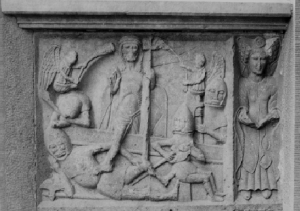Impact and influence
Published in Issue 1 (January/February 2014), Volume 22
Freestone panel—clearly inspired by English alabasters—of the Resurrection from the Creagh tomb in the Franciscan friary at Ennis, Co. Clare. Originally erected by More Ni Brien in about 1470 as a tomb for her husband and the MacMahon family, the ensemble was remodelled, together with panels from another tomb, in the nineteenth century into a resting place for the Creaghs of Dangan. (Edwin Rae Collection, TIARC)
Judging from the number of alabasters that survive in Ireland today, the size of the Irish market for English alabasters would seem to have been fairly modest. Yet the alabasters that did reach Ireland certainly made their mark in one corner of County Clare. The influence of the Midlands sculptors can be seen on the freestone panels on the Creagh tomb (c. 1470) at Ennis, Co. Clare, of the Betrayal, Flagellation, Crucifixion, Entombment and Resurrection. These Irish panels are clearly modelled on English alabaster panels of the same scenes. That being so, the sculptural technique of the Creagh reliefs remains powerfully Gaelic—more incision than high relief, and even more powerfully abstracted than English alabaster work. And another distinct reminder of medieval Irish life is present in the Creagh carving: in the Resurrection panel, the soldier on the right grasps not the usual ‘pollaxe’ or spear but a weapon strongly reminiscent of the axes commonly wielded by galloglass—an unmistakable motif of medieval Irish power politics given that galloglass, fearsome axe-wielding mercenaries from the Scottish Highlands and Islands, were the country’s decisive military élite from the mid-thirteenth century, and often the only means by which a chief could hope to stay in power.


















